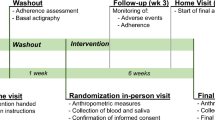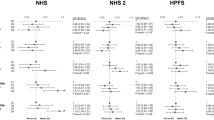Abstract
Objective:
To assess the effect of an increased consumption of vegetables and fruit on body weight, risk factors for cardiovascular disease (CVD) and antioxidant defense in obese patients with sleep-related breathing disorders (SRBD).
Design:
Randomized, controlled trial of an intervention to increase the intake of vegetables to 400 g/day and fruit to 300 g/day. Dietary intake was calculated from a food frequency questionnaire. Antioxidant status was assessed with the ferric-reducing/antioxidant power (FRAP) assay. Plasma carotenoids were biomarkers for the intake of vegetables and fruit.
Setting:
A hospital clinic preventing risk factors for CVD.
Subjects:
Subjects were 103 men and 35 women with a body mass index of 36.7±5.8 kg/m2 of which 57 (86%) in the control and 68 (94%) in the intervention group completed the study.
Intervention:
Group-based behavioral program during 3 months.
Results:
The mean between group differences in body weight was −2.0% (95% CI −3.6, −0.5), P<0.0001. The mean between group difference in systolic and diastolic blood pressure (BP) was −7.1 mm Hg (95% CI: −11.6, −2.6), P=0.0022 and −3.9 mm Hg (95% CI: −7.0, −0.9), P=0.0120, respectively. The mean change in daily intake of vegetables and fruit was 12 g (95% CI: −33, 57) and −4 g (95% CI: −79, 71) versus 245 g (95% CI: 194, 296) and 248 g (95% CI: 176, 320) in the control and intervention groups, respectively. This was reflected in higher concentrations of α-carotene and β-carotene. No change in FRAP was seen. In a multiple regression analysis the change in intake of vegetables was a significant contributor (Radj2=0.073 (95% CI: 0.019, 0.214)) to the change in weight.
Conclusion:
Targeted dietary advice to increase the intake of vegetables and fruit among subjects with SRBD contributed to weight reduction and reduced systolic and diastolic BP, but had no effect on antioxidant defense measured with FRAP.
Sponsorship:
None.
This is a preview of subscription content, access via your institution
Access options
Subscribe to this journal
Receive 12 print issues and online access
$259.00 per year
only $21.58 per issue
Buy this article
- Purchase on Springer Link
- Instant access to full article PDF
Prices may be subject to local taxes which are calculated during checkout
Similar content being viewed by others
References
Al-Delaimy WK, Ferrari P, Slimani N, Pala V, Johansson I, Nilsson S et al. (2005). Plasma carotenoids as biomarkers of intake of fruits and vegetables: individual-level correlations in the European Prospective Investigation into Cancer and Nutrition (EPIC). Eur J Clin Nutr 59, 1387–1396.
Appel LJ, Champagne CM, Harsha DW, Obarzanek E, Elmer PJ, Stevens VJ et al. (2003). Effects of comprehensive lifestyle modification on blood pressure control. Main results of the PREMIER clinical trial. JAMA 289, 2083–2093.
Appel LJ, Moore TJ, Obarzanek E, Vollmer WM, Svetkey LP, Sacks FM et al. (1997). A clinical trial of the effects of dietary patterns on blood pressure. N Engl J Med 336, 1117–1124.
Appel LJ, Sacks FM, Carey VJ, Obarzanek E, Swain JF, Miller ER et al. (2005). Effects of protein, monounsaturated fat and carbohydrate intake on blood pressure and serum lipids. Results of the OmniHeart trial. JAMA 294, 2455–2464.
Becker HF, Jerrentrup A, Ploch T, Psych D, Grote L, Penzel T et al. (2003). Effect of nasal continuous positive airway pressure treatment on BP in patients with obstructive sleep apnea. Circulation 107, 68–73.
Benzie IF, Strain JJ (1999). Ferric reducing/antioxidant power assay: direct measure of total antioxidant activity of biological fluids and modified version for simultaneous measurement of total antioxidant power and ascorbic acid concentration. Methods Enzymol 299, 15–27.
Caples SM, Gami AS, Somers VK (2005). Obstructive sleep apnea. Ann Intern Med 142, 187–197.
Dandona P, Mohanty P, Ghanim H, Aljada A, Browne R, Hamouda W et al. (2001). The suppressive effect of dietary restriction and weight loss in the obese on the generation of reactive oxygen species by leucocytes, lipid peroxidation and protein carbonylation. J Clin Endocrinol Metab 86, 355–362.
Dauchet L, Amouyel P, Hercberg S, Dallongeville J (2006). Fruit and vegetable consumption risk of coronary heart disease: A meta-analysis of cohort studies. J Nutr 136, 2588–2593.
Dragland S, Senoo H, Wake K, Holte K, Blomhoff R (2003). Several culinary and medicinal herbs are important sources of dietary antioxidants. J Nutr 133, 1286–1290.
Dragsted LO, Pedersen A, Hermetter A, Basu S, Hansen M, Haren GR et al. (2004). The 6-a-day study: effects of fruit and vegetables on markers of oxidative stress and on antioxidative defence in healthy non-smokers. Am J Clin Nutr 79, 1060–1072.
Dyugovskaya L, Lavie P, Lavie L (2002). Increased adhesion molecules expression and production of reactive oxygen species in leucocytes of sleep apnesa patients. Am J Respir Crit Care Med 165, 934–939.
Fletcher EC (2003). Sympathetic over activity in the etiology of hypertension of obstructive sleep apnea. Sleep 26, 15–19.
Foster GD, Wadden TA, Voght RA, Brewer G (1997). What is a reasonable weight loss? Patients' expectations and evaluations of obesity treatment outcomes? J Consult Clin Psychol 65, 79–85.
Halvorsen BL, Holte K, Myhrstad I, Barikmo I, Hvattum E, Remberg SF et al. (2002). A systematic screening of total antioxidants in dietary plants. J Nutr 132, 461–471.
Krauss RM, Deckelbaum RJ, Ernst N, Fisher E, Howard BV, Knopp RH et al. (1996). Dietary guidelines for healthy American adults. A statement for health professionals from the Nutrition Committee, American Heart Association. Circulation 94, 1795–1800.
Lavie L (2003). Obstructive sleep apnoea syndrome: an oxidative stress disorder. Sleep Med Rev 7, 35–51.
Lavie P (2004). Pro: sleep apnea causes cardiovascular disease. Am J Respir Crit Care Med 169, 147–148; discussion 150.
Lefevre M, Champagne CM, Tulley RT, Rood JC, Most M (2005). Individual variability in cardiovascular disease risk factor responses to low-fat and low-saturated fat diets in men: body mass index, adiposity, and insulin resistance predict changes in LDL cholesterol. Am J Clin Nutr 82, 957–963.
Little P, Kelly J, Barnett J, Dorward M, Margetts B, Warm D (2004). Randomised controlled factorial trial of dietary advice for patients with a single high blood pressure reading in primary care. BMJ 328, 1054–1059.
Lopes HF, Martin KL, Nashar K, Morrow JD, Goodfriend TL, Egan BM (2003). DASH diet lowers blood pressure and lipid-induced oxidative stress in obesity. Hypertension 41, 422–430.
Loube DI, Loube AA, Erman MK (1997). Continuous positive ariway pressure treatment results in weight loss in obese and overweight patients with obstructive sleep apnea. JADA 97, 896–897.
Newman AB, Nieto FJ, Guidry U, Lind BK, Redline S, Shahar E et al. (2001). Relation of sleep-disordered breathing to cardiovascular disease risk factors – the Sleep Heart Health Study. Am J Epidemiol 154, 50–59.
Nowson CA, Worsley A, Margerison C, Jorna MK, Godfrey SJ, Booth A (2005). Blood pressure change with weight loss is affected by diet type in men. Am J Clin Nutr 81, 983–989.
Peppard PE, Young T, Palta M, Dempsey J, Skatrud J (2000). Longitudinal study of moderate weight change and sleep-disordered breathing. JAMA 284, 3015–3021.
Pillar G, Peled R, Lavie P (1994). Recurrence of sleep apnea without concommitant weight increase 7.5 years after weight reduction surgery. Chest 106, 1702–1704.
Punjabi NM, Shahar E, Redline S, Gottlieb DJ, Givelber R, Resnick HE et al. (2004). Sleep-disordered breathing, glucose intolerance, and insulin resistance: the Sleep Heart Health Study. Am J Epidemiol 160, 521–530.
Rimestad AH, Blaker B, Færden K, Flåten AM, Lund-Larsen K, Nordbotten K : Trygg K. Den store matvaretabellen. (The Norwegian food composition table) (1995): Universitetsforlaget: Oslo, Norway.
Schultz R, Mahmoudi S, Hattar K, Sibelius U, Olschewski H, Mayer K et al. (2000). Enhanced release of superoxide from polymorphonuclear neutrophils in obstructive sleep apnea: impact of continous positive airway pressure therapy. Am J Respir Crit Care Med 162, 566–570.
Shamsuzzaman ASM, Winnicki M, Lanfranchi P, Wolk R, Kara T, Accurso V et al. (2002). Elevated C-reactive protein in patients with obstructive sleep apnea. Circulation 105, 2462–2464.
Shneerson J, Wright J (2001). Lifestyle modification for obstructive sleep apnoea. Cochrane Database of Systematic Reviews 1, CD002875.
Stradling J (2004). Con: sleep apnea does not cause cardiovascular disease. Am J Respir Crit Care Med 169, 148–149; discussion 150.
Strobel RJ, Rosen RC (1996). Obesity and weight loss in obstructive sleep apnea: a critical review. Sleep 19, 104–115.
Svatikova A, Wolk R, Lerman LO, Juncos LA, Greene EL, McConnell JP et al. (2005). Oxidative stress in obstructive sleep apnoea. Eur Heart J 26, 2435–2439.
Svendsen M, Tonstad S (2006). Accuracy of food intake reporting in obese subjects with metabolic risk factors. Brit J Nutr 95, 640–649.
Tooze JA, Subar AF, Thompson FE, Troiano R, Schatzkin A, Kipnis V (2004). Psychosocial predictors of energy under-reporting in a large doubly labelled water study. Am J Clin Nutr 79, 795–804.
Weinberger MH (2005). More novel effects of diet on blood pressure and lipids. JAMA 294, 2497–2498.
World Health Organization (1997). Obesity. Preventing and managing the global epidemic. Report of a WHO consultation on obesity 1997. World Health Organization: Geneva, Switzerland. [WHO/NUT/NCD/98.1].
Acknowledgements
We thank Tor Ole Klemsdal for some of the medical examinations and Hanne Dyrendal for the dietary calculations. We also thank the subjects who took part in this study. ST and MS contributed to the development of the protocol. MS performed all the dietary assessments and analyzed the data. IH assisted with the statistical analyses and RB was responsible for the FRAP and caretenoid analyses. None of the authors had any personal or financial conflicts of interest.
Author information
Authors and Affiliations
Corresponding author
Additional information
Funding source: None.
Rights and permissions
About this article
Cite this article
Svendsen, M., Blomhoff, R., Holme, I. et al. The effect of an increased intake of vegetables and fruit on weight loss, blood pressure and antioxidant defense in subjects with sleep related breathing disorders. Eur J Clin Nutr 61, 1301–1311 (2007). https://doi.org/10.1038/sj.ejcn.1602652
Received:
Revised:
Accepted:
Published:
Issue Date:
DOI: https://doi.org/10.1038/sj.ejcn.1602652
Keywords
This article is cited by
-
Position statement on nutrition therapy for overweight and obesity: nutrition department of the Brazilian association for the study of obesity and metabolic syndrome (ABESO—2022)
Diabetology & Metabolic Syndrome (2023)
-
Dietary energy density and obesity: how consumption patterns differ by body weight status
European Journal of Nutrition (2018)
-
The impact of diet and lifestyle management strategies for obstructive sleep apnoea in adults: a systematic review and meta-analysis of randomised controlled trials
Sleep and Breathing (2013)
-
Weight change in control group participants in behavioural weight loss interventions: a systematic review and meta-regression study
BMC Medical Research Methodology (2012)
-
Orlistat after initial dietary/behavioural treatment: changes in body weight and dietary maintenance in subjects with sleep related breathing disorders
Nutrition Journal (2011)



